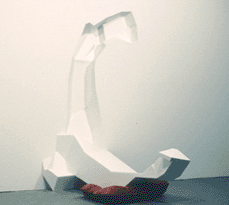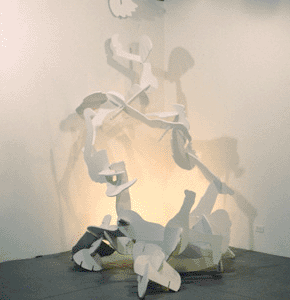|
|
Christian Maychack at Lucky Tackle Christian Maychack's recent show in Oakland presented three new pieces that furthered his explorations of scale, balance and humor. While using less color and fabric here than in earlier works, there was still strong evidence of a sharp wit, as well as a sharp eye for creating the appearance of a kind of movement or dramatic tension within the sculptures themselves.
Upon entering the one-room space, one is immediately confronted with a site-specific sculptural installation that literally comes out of the wall. Though the untitled piece was likely a discreet object fashioned to interact with the walls and floor of the gallery, it appears as if a large, misshapen chunk of the wall had actually been partially carved out and peeled back towards the floor. This drywall extrusion now "rested" on a fluffy red couch cushion, as if to either buffer the floor from any marks and scratches, or to give the sculpture a more gentle landing place. The shadows produced by the lighting not only amplified the interesting formal choices made by Maychack's "cuts," but also cast the gaping "wound" in the wall with a brooding and crepuscular depth. The softness of the pillow humorously countered the more harsh aspects of the angular edges and corners of the sculpture, while the cushion's lush red surface hinted at a kind of violence inherent in the piece's very (de)construction. The Long Goodbye, a large, somewhat complicated structure, leaned (or appeared to lean) against the opposite walls and corner. The sculpture incorporated what seemed to be several distinct pieces, fashioned together by a series of cuts and insertions. Each individual segment was constructed from gatorfoam and then covered in patterned white wallpaper. The pieces were mostly cut into shapes resembling human arms and legs and various animal parts, as if they had all been taken from an oversized children's toy zoology set. The overall effect was one of a delicate balancing act akin to a house of cards, even if the separate segments were not so separate after all, and actually tightly fastened together. One could thus not tell if the piece was as sturdy as it was massive or if it was ready to collapse at a sudden gust of wind from the open doorway. Again, the gallery lighting helped produce a mish-mash of dancing shadows, giving the sculpture a further sense of depth and nuance of surface coloration.
The
third and final piece in the exhibit, much smaller than the others,
was held to the wall by two hooks. Here hung a kind of wooden arm of
sorts, topped off by a twisting detail of brown and blue upholstery
and brightly colored pushpins. This sculpture was at once both creepy
and fun, slightly menacing as well as inviting, like a mutant appendage
to a Pinocchio doll. Like all uncanny objects, the mix of repulsion
and fascination both attracted and repelled the viewer, with a sense
of playful danger belonging to what might have been an ad-hoc weapon
made of cast-off home-ec materials or a talisman against proper and
genteel artistic forms. All of Maychack's works seemed to function in
this dialectic, wherein a clear playfulness and wit exerted itself side
by side with a threat of collapse or violence. A deconstructionist approach
to the expectations of sculpture (and its "weighty" pretenses, especially
since the rather grandiose minimalist era) helps hold such confliction
sensibilities in a kind of delicate balance. The sculptures refuse to
be nice, safe objects, even if presenting themselves as kinds of overstuffed
adult toys, and it is this dual effect that makes Maychack's work successful. David Buuck is a freelance writer based in San Francisco. Originally published September ,2003 :: Artweek Vol 34 Issue 7 |
||||


